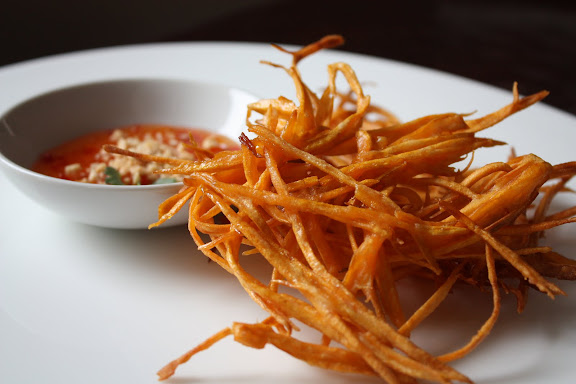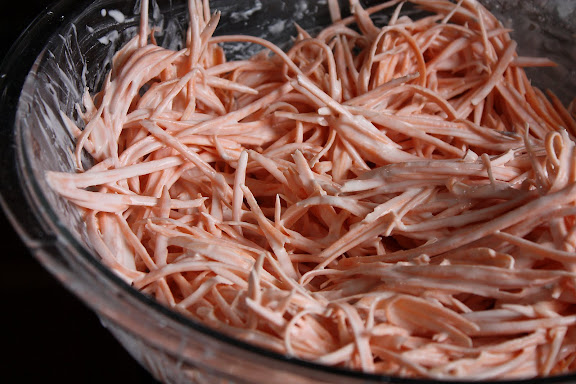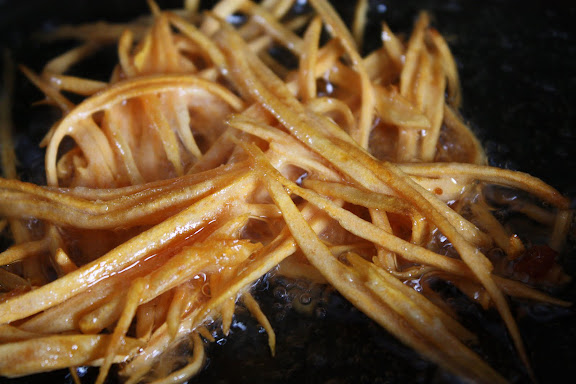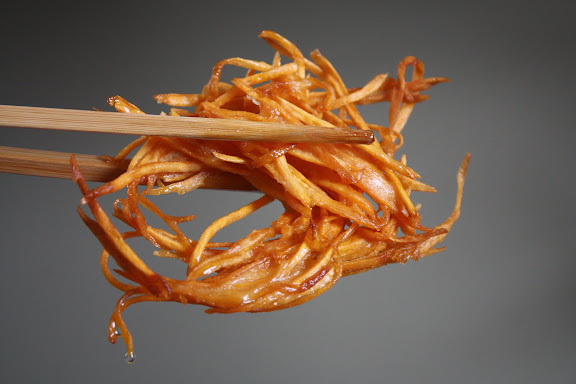
In continuing our Stock Your Thai Pantry series, one item that must be mentioned is Sriracha sauce (ซ้อสศรีราชา) — the all-purpose hot sauce that, according to the most prominent yet unsubstantiated theory, originated from a city after which it was named. I can’t think of any hot sauce that is more widely used and versatile when it comes to the modern Thai cuisine. Even though Sriracha has become a generic name for similar hot sauces made both domestically and outside of Thailand, the Thai palates don’t have a hard time recognizing the authentic spicy, sweet, tangy, garlicky sauce that we grew up with. Continue Reading →
Archive | She Thais RSS feed for this section
Homemade Sriracha – How to Make Thai Sriracha ซ้อสศรีราชา
Sweet Potato Fritters with Thai Sweet Chilli Sauce

Remember GFB’s coconut batter-fried sweet potatoes from last year? This version is just as good, if not better. The batter is simpler and lighter. The sweet potatoes are shredded more finely into long, thin strands, resulting in much, much crispier, bird’s nest-like fritters that bear more resemblance to shoestring potatoes than potato fries. The only thing that remains the same is the dipping sauce, a perfect mixture of Thai sweet chilli sauce, chopped roasted peanuts, and chopped fresh cilantro. Some things just can’t be improved upon, I guess.
To make enough of these fritters as an appetizer for six people (or four hungry people), you need 1.5 pounds of sweet potatoes. Peel them and shred them as finely as you can into long, thin strands. If you have a food processor that can do that, that’s great. If not, go for the Kiwi Pro-Slice Thai Peeler. These uni-tasking hand-shredders don’t take up much space, and do the job very well. I have one just for shredding green papaya to make Thai papaya salad (Som Tam ส้มตำ).

For extra crispy fritters — the kind that, as you bite into them, creates the crackling noises in your skull like those you get from bad radio station reception — you may want to add this extra step. Spread out the sweet potato strands in a single layer on a large cookie sheet and let them dehydrate in a very low oven — 100°F — for 2-3 hours. Some discoloration will occur, but it’s not so bad and the crispiness you get out of it more than makes up for the slightly marred appearance.
You see, moisture inside whatever it is you’re frying is precisely what makes it soggy. Moisture turns into steam when heated and the only way to ensure crispiness and long retention of that crispiness is to eliminate as much moisture as possible from the object.

However, if you don’t want to add that extra step, that’s perfectly fine, especially if you know you will consume all of these delicious fritters within an hour or two after they’ve been fried.
The next step is to whisk together 6 ounces (about 1 1/2 cups) of rice flour and one teaspoon of salt with 8 fluid ounces (one cup) of either plain carbonated water or plain water with one teaspoon of baking soda added. Add the sweet potato strands to the batter and stir just to make sure each and every strand is well coated.

What I hate the most about frying anything is the fact that I have to dispose of the oil afterward. Therefore, I limit the amount of the oil by using a small frying pan and fry in more batches. For this large batch, I used only 1 1/4 cups of vegetable oil and shallow-fried the fritters in an 8-inch fry pan.
One really great thing about these fritters is that they absorb surprisingly very little oil (the leftover oil measured a couple of tablespoons shy of a cup after I’d fried up the entire batch). Since the batter is very light and the sweet potato strands are very thin, they crisp up almost immediately the moment they hit the oil. Once one side browns up, you flip it over and in less than a minute it’s ready. Transfer them to a paper towel-lined pan immediately.

The trick is to spread out the potato “nests” when you lower the strands into the pan. The more spread-out the nests, the less moisture retention. The less moisture, the more quickly they crisp up and the longer they stay crisp. Also, don’t crowd the pan. You want the oil temperature to stay as even as possible. Crowding the pan will cause the temperature to dip too low and cause the fritters to absorb too much oil.

For the dipping sauce, mix together 1.5 cups of Thai sweet chilli sauce, 1/2 cup of chopped roasted peanuts, and 2 tablespoons of chopped cilantro leaves.
Nam Pla Prik น้ำปลาพริก – The Ubiquitous Thai Table Sauce

This simple table sauce is so commonplace — lowly even — in the Thai households that it’s almost ridiculous for me to blog about it. A blog post on this sauce is in many ways like a blog post on table salt and pepper. And I bet this post, just like a few similar ones in the past, will bring my way many have-you-run-out-of-stuff-to-blog-about-HUH? email and voice messages from my friends and family in Thailand.
Oh, well.
My only justification is that although nam pla prik(RTGS: nam pla phrik), or sometimes called prik nam pla, is considered ordinary, its presence cannot be ignored. This meal accompaniment is one of the most ubiquitous items in the Thai cuisine. Everywhere you look, you see it. On make-shift tables set up by street food vendors. On the tables of sit-down type of restaurants. On your family dining table. On the seasoning table in every corner of every food court. In a tiny bowl that comes with the plate of fried rice you order. In a little rubber band-fastened plastic bag nestled inside your fried rice to-go box.
You see it everywhere.
I was tempted to call it a dipping sauce, but that somehow feels weird to me as it’s not something we dip stuff into in the manner of buffalo wings and bleu cheese dip. If anything, nam pla prik acts more like a flavor enhancer (mainly for rice or rice-based dishes). You take a spoonful of it and drizzle over or mix into whatever it is that’s on your plate. If your fried rice is a little bland, or could use some heat, a dab of fish sauce and a few pieces of fresh chilies would be of tremendous help. Sometimes, having a little bit of the vibrant kick of fresh chilies along with rice and curry makes for a very pleasant meal.
Most Thai food vendors aren’t so sensitive when it comes to the customers adding seasonings to their food; most of them don’t take it personally. If anything, they seem to encourage self-customization. Anyone who has eaten street noodles in Thailand is familiar with the seasoning set that’s always there on the table for people to use, not to visually admire from afar or meditate on as you eat your noodles.
When my mother was alive, if we had invited any of you guys to our house for a meal, I can assure you that the infamous Joy Luck Club scene, where the (Chinese) mother is greatly insulted by her daughter’s (white) boyfriend naïvely adding soy sauce to her signature dish, would never happen at our house. The members of my entire clan, thankfully, are beyond laid-back. My mother would’ve definitely put a bowl of nam pla prik in the middle of the table for everyone just in case. And if you actually used it, she would never have taken offense.
Notice that when you eat at a Thai restaurant, sometimes Thai diners will ask their server for a bowl of nam pla prik — a reasonable request that is in most cases gladly fulfilled with no extra charge. In some restaurants, once they know you’re Thai, they bring out a bowl of nam pla prik along with your order without you even asking. When I see non-Thais request a bowl of nam pla prik at a Thai restaurant, I automatically assume they either live with a Thai or have lived in Thailand for extended periods of time.
I’m not much of a nam pla prik addict in the sense that I don’t automatically add it to everything that’s put in front of me. I only use it when it really makes a difference. In fact, I can only think of one thing that I refuse to eat without a bowl of nam pla prik nearby: rice and soft- or hard-boiled eggs. Take nam pla prik away from the picture and the whole thing becomes pointless to me. Nothing else can take the place of nam pla prik in that situation, not even my beloved Maggi or Sriracha. But in most situations, I can easily get by without it.
Each person approaches the stuff differently, though. Many consider nam pla prik to be the side item without which a meal is not complete. Someone I know can get really cranky if she makes herself a bowl of rice topped with crispy fried eggs and sits down to enjoy it only to find the last person who finished the last batch of nam pla prik didn’t replenish the stock. This could cause friction in the household.
Each person (or family) has his own idea of what nam pla prik consists of. I’m a minimalist, so as long as there are thin slices of fresh bird’s eye chillies floating happily in a pool of aromatic fish sauce, I’m happy. In fact, I would say that those two components are the bare essentials of nam pla prik., i.e. as long as you have fish sauce and fresh chillies, you have nam-pla prik. After all, the name nam-pla prik is made by sticking two nouns together: nam pla (fish sauce) and prik (chilli). But it wouldn’t be uncommon to see sliced garlic or shallots floating in there as well.
Try asking for nam pla prik next time you visit a Thai restaurant and look for that subtle ah!-you-eat-like-we-do expression on your server’s face. And if they actually give you a bowl of it gratis, please tip them well and support their business for that is a sign of hospitality — of them welcoming you into their “home.”
Enter your email to subscribe:
ARCHIVES
-
 Subscribe to The Epestle to Receive New Posts
June 30, 2021
Subscribe to The Epestle to Receive New Posts
June 30, 2021
-
 Introducing THE EPESTLE
February 13, 2021
Introducing THE EPESTLE
February 13, 2021
-
 Bury Me in Nam Phrik: Mike Sula’s Exploration of Thai Relishes (Plus Salted Soybean-Pork Rind Relish Recipe)
May 1, 2018
Bury Me in Nam Phrik: Mike Sula’s Exploration of Thai Relishes (Plus Salted Soybean-Pork Rind Relish Recipe)
May 1, 2018
-
 Food and Cooking in Thai TV Dramas, Love Destiny, 17th Century Siam, and Crispy Noodle-Wrapped Pork Dumplings
April 2, 2018
Food and Cooking in Thai TV Dramas, Love Destiny, 17th Century Siam, and Crispy Noodle-Wrapped Pork Dumplings
April 2, 2018
-
 A Simple Thai Dipping Sauce
March 12, 2018
A Simple Thai Dipping Sauce
March 12, 2018
-
 Northern Thai Rice Noodle Soup with Pork Ribs, Dried Cotton Flowers, and Tomatoes (Khanom Jin Nam Ngiao)
September 1, 2017
Northern Thai Rice Noodle Soup with Pork Ribs, Dried Cotton Flowers, and Tomatoes (Khanom Jin Nam Ngiao)
September 1, 2017
-
 How to Prepare Rice Vermicelli (Khanom Jin) from Dried Noodles
August 29, 2017
How to Prepare Rice Vermicelli (Khanom Jin) from Dried Noodles
August 29, 2017
-
 How to Prepare Pomelos for Thai Pomelo Salad
May 23, 2017
How to Prepare Pomelos for Thai Pomelo Salad
May 23, 2017











